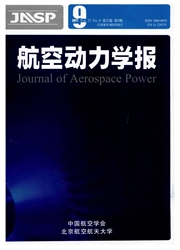

 中文摘要:
中文摘要:
采用脉冲爆震燃烧室(PDC)与涡轮增压器组合,汽油和空气作为燃料和氧化剂,进行了PDC与涡轮组合的原理性模型试验装置的试验,研究了作为涡轮负载的压气机的性能随点火频率变化的趋势。试验结果表明:脉冲爆震燃烧室在1~10 Hz点火频率范围内稳定工作,在PDC内得到了充分发展的爆震波;当点火频率为10 Hz时,涡轮带动压气机产生的压气机压比为1.216,压气机功率和压缩等熵功率为2.756 kW和1.663 kW,压气机效率为0.603,与涡轮增压器厂家数据基本吻合;当点火频率增大时,压气机压比、压气机加给每千克空气的功、压气机功率和压缩等熵功率以及压气机效率增大,涡轮做功增大。
 英文摘要:
英文摘要:
Aim. In our discussion at the beginning of the paper, in order to make further advance in PDC research, we conclude preliminarily that it is necessary to estimate the effect of cyclic high pressure pulses on turbine performances. Fig. 1 in the full paper shows the block diagram of our experimental setup. Fig. 4 shows the experimental data of the compressor outlet air mass flow versus PDC inlet air mass flow under cold flow or detonation conditions. Fig. 5 shows the experimental data of the compressor pressure ratio versus detonation frequency. Fig. 6 shows the experimental data of: (1) compressor work versus detonation frequency; (2) isentropic compression work versus detonation frequency. Fig. 7 shows the experimental data oft (1) compressor power versus detonation frequency; (2) isentropic compression power versus detonation frequency. Fig. 8 shows the experimental data of compressor efficiency versus detonation frequency. The experimental results show preliminarily that: (1) the PDC works stably when its detonation frequency is from 1 to 10 Hz; (2) when the detonation frequency is 10 Hz, the pressure ratio of the compressor driven by a turbine is 1. 216; (3) the compressor power and isentropic compression power are 2. 756 kW and 1. 663 kW respectively, meaning that the compressor efficiency is 0. 603. The experimental results are in good agreement with the measured data provided by a turbocharger manufacturer. The compressor pressure ratio, compressor power, isentropic compression power, compressor efficiency, and turbine power all increase with increasing detonation frequency.
 同期刊论文项目
同期刊论文项目
 同项目期刊论文
同项目期刊论文
 期刊信息
期刊信息
